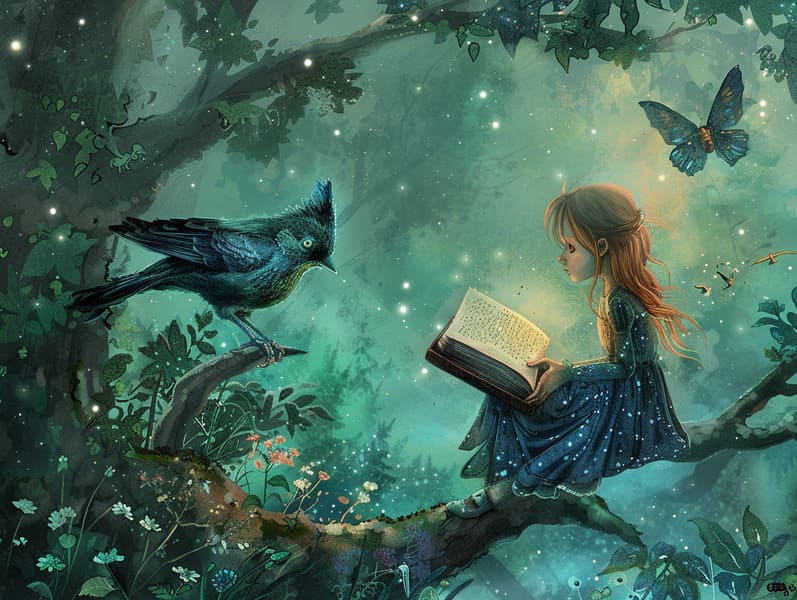
Legendary fairy tales have historical significance. These stories have been told from one generation to the next far before they were ever inscribed. They came from a variety of cultures, including Asian traditions. They were initially narrated among older generations, often carrying themes and messages relevant to the societal norms and beliefs of the time.
The Grimm brothers, the two Grimm brothers, were among the first to gather many of these beloved stories. Their volume, "Grimm's Fairy Stories," included tales like "The Story of Cinderella," "Hansel and Grethel," and "Snow-White and Rose-Red," which have since become staples in the world of beloved fairy tales. Similarly, Andersen's delightful tales, such as "The Mermaid," and "The Ugly Duckling," have gained the love worldwide, guaranteeing their place in the pantheon of iconic fairy tales.
Even though they are old, these stories remain as relevant as ever, especially as kids' bedtime tales. These enchanting tales are now available in multiple formats, including gorgeously illustrated books, whimsical animations, and online storybooks.
Their continued relevance can be ascribed to several whimsical characteristics:
Significant Morals: Timeless fairy tales often convey important moral lessons. Fairy tales like "The Boy Who Cried Wolf" teach the significance of honesty, while "The Story of the Tortoise and the Hare" demonstrate the qualities of steadfastness and humility. These stories offer young readers clear distinctions between virtue and vice, developing their moral compass in a kind yet lasting way.
Compassion and Knowledge: Classic fairy tales frequently feature heroes facing difficulties and adversities, inciting young readers to relate with their struggles and applaud their triumphs. For instance, "The Story of Beauty and the Beast" demonstrates the benefit of seeing beyond the surface to comprehend the inner core of a character, building kindness and awareness.
Cultural Awareness: Many timeless fairy tales are steeped in the cultural contexts from which they emerged. Delving into these narratives can provide delightful insights into different beliefs, nurturing a sense of cultural respect and comprehension.
Creativity and Imagination: The supernatural elements in traditional fairy tales—supernatural elements—trigger children’s visions. These fairy tales take readers to enchanted realms, engendering inventive thinking and a sense of marvel that continues a lifetime.
Old fairy tales are not only enchanting but also illuminating. They function as fantastical tools in building various mind and heart abilities in young ones. When classic fairy tales are spoken, they nurture speaking abilities by bringing new terms and meanings and intricate sentence structures. This practice also advances listening abilities and mental focus, as young readers pay close attention, looking forward to see what happens next.
Furthermore, exploring the themes and characters of old fairy tales can advance critical thinking and thought processes. Young ones are shown to see patterns, forecast, and make sense of cause and click here effect. These analyses also ease young ones reveal their thoughts and feelings, nurturing their emotional intelligence.
In today’s electronic age, the existence of online fairy tales has made these fairy tales more acquirable than ever. Online platforms and apps extend comprehensive collections of children's fairy tales that can be experienced or listened to anytime, anywhere. Fairy tales read aloud are particularly liked, giving an fun way for little ones to engage with these entrancing tales. Audiobooks and read-out-loud videos bring characters and settings to life, often paired with fantastical background sounds and melodies that enrich the story adventure.
The everlasting appeal of ancient fairy tales lies in their ability to alter to current eras while holding onto their basic principles. Contemporary updates of these stories often present more diverse figures and modern settings, making them relatable to today’s audience. However, the fundamental themes of valor, humanity, and fairness remain unchanged, continuing to affect kids of all ages.
Classic fairy tales also offer a sense of ease and knownness. They impart a coherent narrative with a unmistakable beginning, middle, and end, often finishing with the settlement of conflicts and the triumph of right over wrong. This reliability can be comforting for children, making available a sense of solidity in an always shifting world.
Ancient fairy tales continue to enchant and train new generations, maintaining their attraction and relevance in modern society. As nighttime stories for kids, they bring a perfect blend of magic and knowledge, enriching moral values, empathy, and creativity. The existence of digital fairy tales and the well-received status of fairy tales spoken confirm that these old narratives remain accessible to new generations.
By perpetuating and disseminating these narratives, we continue to praise the rich tapestry of tales and cultural heritage. Whether you are viewing a artistically illustrated book, browsing a internet library, or listening on an voice book, the charm of traditional fairy tales is always within reach. These stories point out of the timeless nature of fairy tales and its ability to unify us across centuries and lands.
No matter if you are discovering a colorful picture book, delving into a online collection, or hearing an audiobook, the enchantment of timeless fairy tales is always within reach.
These stories illustrate of the endless magic of narratives and its ability to bind us across generations and cultures, forming a connection that delights and instructs alike.